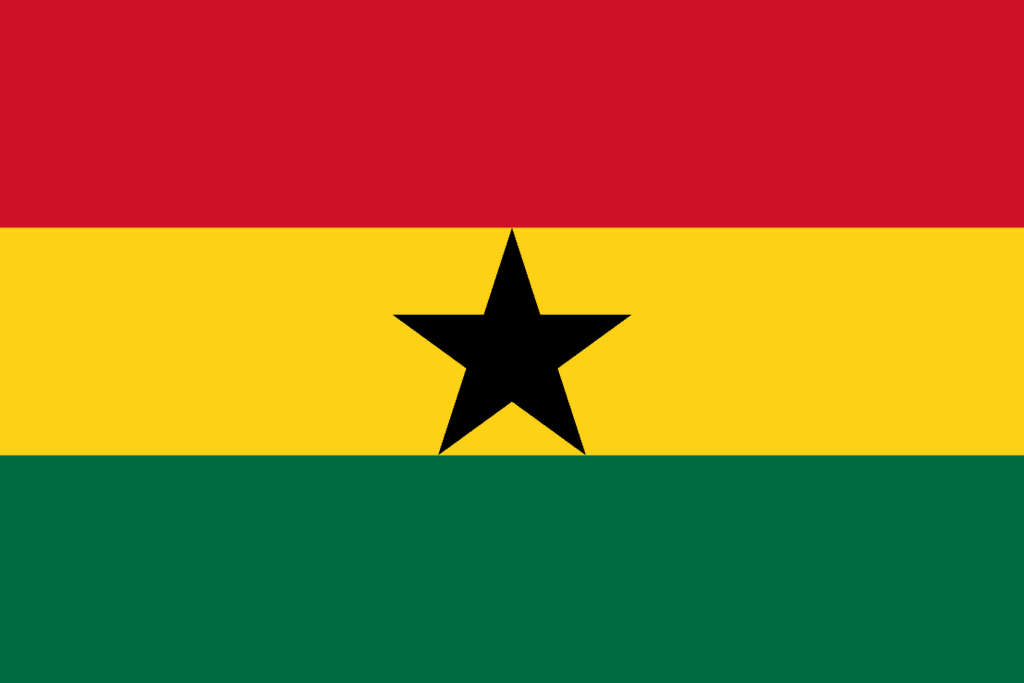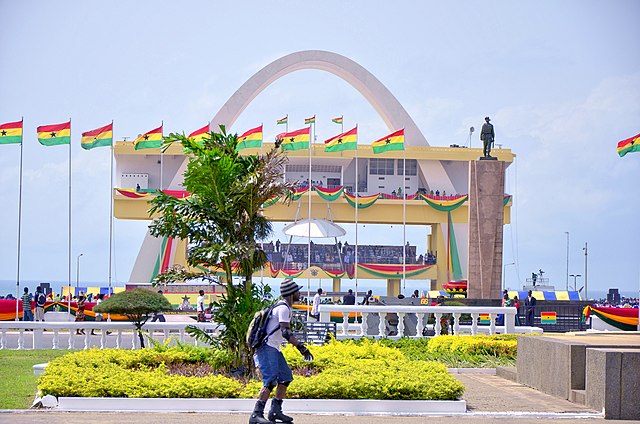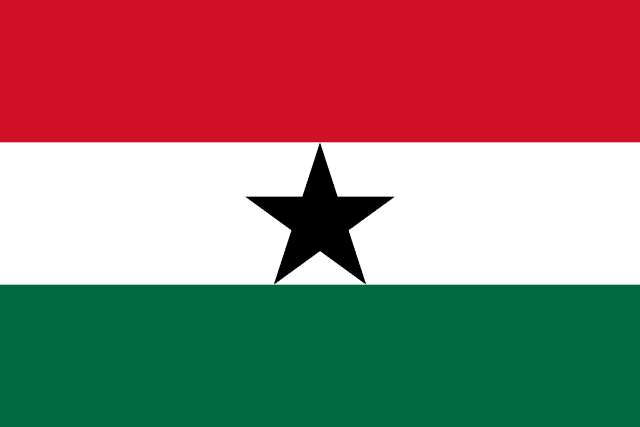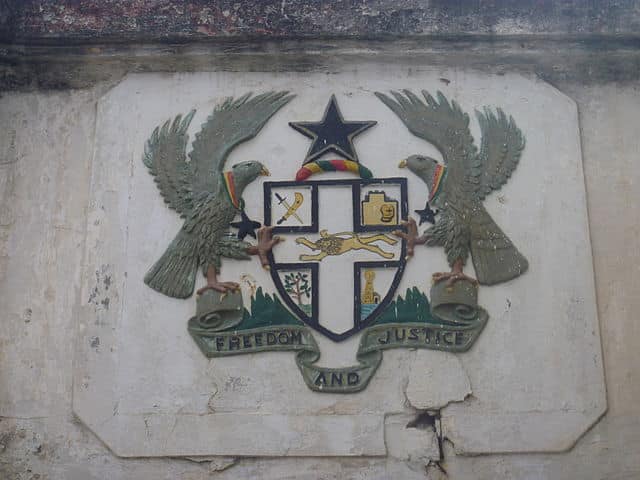The Ghanaian national flag was created and accepted in 1957. The flag was flown until 1962 when it was reinstituted. The Ghana flag was designed to serve as a symbol of celebration during the period after independence. Interestingly, several flags were also created to represent this country, but the current Ghana flag is the only one that fully represents the country’s customs and values.
Do you enjoy learning about flags, their origin, and their symbolic meaning? Then this interesting overview of the Ghana flag will definitely satisfy your curiosity.

Briefly About Ghanaian Culture
Before actually moving on to the discussion of what the Ghana flag looks like and what the symbolic meaning behind it is, let’s explore the country’s profile and discuss Ghanaian culture.
Ghana is a tropical country with an abundance of greenery. Not surprisingly, the colors of the Ghana flag are greatly influenced by Ghana’s topography. Ghana, a country in western Africa, only has a one-time zone, known as Greenwich Mean Time. Ghana shares the current time zone with 14 other African countries. The time in Ghana is GMT.
Ghana is a West African country located between Togo and the Ivory Coast. Burkina Faso forms the northern boundary, and the Gulf of Guinea forms the southern border. The nation is not much bigger than the state of Oregon. The majority of the terrain is made up of low plateaus and plains that are bordered by rainforests in the west and Lake Volta in the east.
The name Ghana was originally given to the country because of its enormous gold resources, but it was subsequently altered as a result of the country’s successful war for independence in 1957. Diamond, bauxite, and manganese are some of Ghana’s other mineral resources.
The majority of Ghana’s cash crops are exported to foreign nations in exchange for hard currency, which is then utilized to build roads, schools, water systems, and other infrastructure, as well as companies that provide jobs.
In Ghana, the president serves as both the nation’s and the government’s top official. Every four years, the president and vice president are elected. The president appoints a council of ministers, which the parliament then approves. The heads of several government departments in the state make up the ministers. In addition to the national government, there is a tribal governance system as well.
The west coast of Africa was part of a historic trading route before the Europeans arrived in pursuit of gold. Portuguese traders arrived in 1471 and saw that the locals were wearing gold jewelry. Portuguese, Danish, Dutch, German, and British people traveled to the Gold Coast in pursuit of gold. In the 20th century, the British seized power in the nation and designated the Gold Coast as a colony of the British Empire.
The Gold Coast became Ghana after it was freed from British rule in 1957. Following a string of corrupt administrations, Jerry Rawlings, Ghana’s new president in 1981, swore to eradicate corruption. When a new constitution was enacted in 1992, democracy with several parties had its beginnings.

History Of Ghana Flag
A Ghana flag was created for the movement when Kwame Nkrumah founded the Convention People’s Party in 1949 to promote more self-government for the local African populations of the British Gold Coast. It was a straight horizontal red-white-green tricolor that became well-recognized throughout the Gold Coast as a representation of modernity and independence. Ghana gained its independence on March 6, 1957, after the introduction of self-government in 1952.
On that day, a national flag was modeled after the banner of the Convention People’s Party, and it was flown throughout the country. Additionally, the nation was given a new name based on the empire of Ghana, which existed from the seventh through the thirteenth centuries and was a wealthy and strong kingdom. Ghana played a key role in the drive for African liberty and unification as the first independent state in sub-Saharan Africa. The original red and green stripes were carried over into the new flag, which also featured a black five-pointed star known as the “lodestar of African liberation.”
In 1964, President Nkrumah instituted one-party control, but he was deposed in 1966. However, on February 28, 1966, the independence flag with its yellow stripe was raised once more as a result of the end of Nkrumah’s leadership.
The Ghana flag is included on the ensign used by the Ghana Air Force. The national civil air ensign serves as a symbol for civil aviation in Ghana. The Ghana flag is shown in the canton on a typical light-blue background. On the fly, it is either charged with a black five-pointed star or a red, yellow, and green roundel. Since Ghana’s 1957 declaration of independence and the following establishment of its air force in 1959, both have been employed.

What Influenced Ghana Flag Design
The design of the Ghana flag is related to the country’s liberation from colonial rule. The Ghanaian flag is a tricolor that alternates between red, gold, and green. The colors symbolize the nation’s fight for independence as well as the wealth of its natural resources, given its geographic position among other African nations.
The crimson of Ghana’s national flag was chosen to symbolize the blood of the forebears who led the freedom movement and shared their blood through death. During the country’s war of independence from the United Kingdom, several influential Ghanaian leaders perished. The big six were Dr. Ako Adjei, William Ofori Atta, Joseph Boakye Danquah, Emmanuel Obetsebi Lamptey, and afterward Osagyefor Dr. Kwame Nkrumah.
The gold color, which dominates the three-color appeal, stands in for the natural riches that are mostly located in Ghana’s Ashanti area and contribute to the nation’s prosperity. One of Ghana’s mineral resources is gold, which is mostly discovered in the Ashanti Region’s Obuasi and the Western Region’s Tarkwa.
The color green represents Ghana’s lush woods and natural resources, as already mentioned above. They are a source of the country’s oil, food, and cash crops, including cocoa, wood, shea butter, and many food items. Green continues to be utilized as a symbol of Ghana’s verdant agricultural landscape.
Symbolic Meaning Behind Ghana Flag
The Ghana flag has three colors on it – gold, red, and green. Gold was inspired by the mineral-rich landscape of our country, and red honors those who gave their lives or contributed to the nation’s freedom.
The black star is a representation of African emancipation, while the red one represents the blood of those who lost their lives fighting for the country’s independence from Great Britain. The Black Star Line, a shipping company founded by Marcus Garvey and operating from 1919 to 1922, served as the inspiration for the black star’s adoption. It is the source of the “Black Stars” moniker for the Ghanaian national football team.
It is made up of three horizontal stripes of the Pan-African colors red, gold, and green, with a black five-pointed star in the middle of the gold stripe. Following the flag of the Ethiopian Empire, the flag of Ghana was the second African flag to use these hues. The design of the flag had an impact on the Guinea flag. Bissau’s Theodosia Okoh created the Ghana flag.
Ghana’s Coat Of Arms
In addition to the Ghana flag, one of the country’s most important representations is its coat of arms. In plain terms, a coat of arms serves as a symbol of identification for a family, group, municipality, or nation. Typically, the coat of arms is created on a shield, which later serves as the community’s emblem. The British and French reigning dynasties are where the coat of arms first came into use.
When Ghana was still a British colony, the term “Gold Coast” was used to refer to the country. The nation at this time utilized a coat of arms created by the British. The Ghana coat of arms is composed of various components, each of which has a significant value.
The shield on the Ghanaian coat of arms is cut into four equal halves by a St. George’s cross. The shield features a different emblem inlaid in each quadrant, and the cross is surrounded by a gold border.
A sword used by chefs and a staff used by the linguist, or “okyeame” in Akan, is depicted in the first quarter’s top left corner. It serves as a representation of Ghana’s traditional leadership. The presidential residence on the Gulf of Guinea is shown as Osu Castle on the water in the second quarter, symbolizing the national administration. The cocoa tree, which represents Ghana’s agricultural prosperity, is shown in the third quarter of the shield.
A gold mine is depicted in the fourth quarter to represent how abundant Ghana’s natural resources and industrial minerals are. The enduring connection between Ghana and the Commonwealth of Nations is symbolized by a gold lion in the center of a green St. George’s Cross with gold fimbriation on a blue background.

Bottom Line
After exploring the history of the Ghana flag and pointing out the symbolism behind it, you probably now understand that the description of the Ghanaian national flag is noteworthy. The flag has been used for a variety of occasions, including national and international holidays like Independence Day and festivities honoring Ghana’s “Big Six” and former presidents.
The Ghana flag is raised to fly in the sky to honor important occasions, but it is typically lowered to fly just partially when the nation has suffered some sort of sorrow.